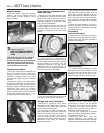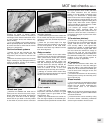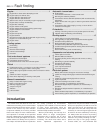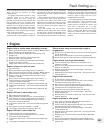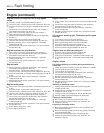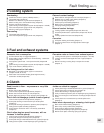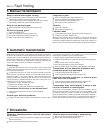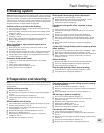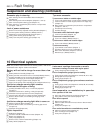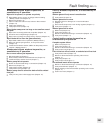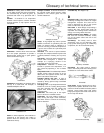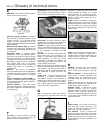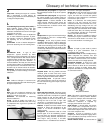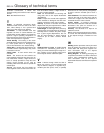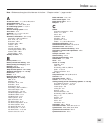
REF•18 Fault finding
10 Electrical system
Note: For problems associated with the starting system, refer to the
faults listed under “Engine” earlier in this Section.
Battery will not hold a charge for more than a few
days
ⅥⅥ Battery defective internally (Chapter 5A).
ⅥⅥ Battery terminal connections loose or corroded(“Weekly checks” ).
ⅥⅥ Auxiliary drivebelt worn or incorrectly adjusted (Chapter 1).
ⅥⅥ Alternator not charging at correct output (Chapter 5A).
ⅥⅥ Alternator or voltage regulator faulty (Chapter 5A).
ⅥⅥ Short-circuit causing continual battery drain (Chapters 5A and 12).
Ignition/no-charge warning light remains
illuminated with engine running
ⅥⅥ Auxiliary drivebelt broken, worn, or incorrectly adjusted
(Chapter 1).
ⅥⅥ Alternator brushes worn, sticking, or dirty (Chapter 5A).
ⅥⅥ Alternator brush springs weak or broken (Chapter 5A).
ⅥⅥ Internal fault in alternator or voltage regulator (Chapter 5A).
ⅥⅥ Broken, disconnected, or loose wiring in charging circuit
(Chapter 5A).
Ignition/no-charge warning light fails to come on
ⅥⅥ Warning light bulb blown (Chapter 12).
ⅥⅥ Broken, disconnected, or loose wiring in warning light circuit
(Chapter 12).
ⅥⅥ Alternator faulty (Chapter 5A).
Lights inoperative
ⅥⅥ Bulb blown (Chapter 12).
ⅥⅥ Corrosion of bulb or bulbholder contacts (Chapter 12).
ⅥⅥ Blown fuse (Chapter 12).
ⅥⅥ Faulty relay (Chapter 12).
ⅥⅥ Broken, loose, or disconnected wiring (Chapter 12).
ⅥⅥ Faulty switch (Chapter 12).
Instrument readings inaccurate or erratic
Instrument readings increase with engine speed
ⅥⅥ Faulty voltage regulator (Chapter 12).
Fuel or temperature gauges give no reading
ⅥⅥ Faulty gauge sender unit (Chapters 3 and 4A, 4B, 4C or 4D).
ⅥⅥ Wiring open-circuit (Chapter 12).
ⅥⅥ Faulty gauge (Chapter 12).
Fuel or temperature gauges give continuous maximum
reading
ⅥⅥ Faulty gauge sender unit (Chapters 3 and 4A, 4B, 4C and 4D).
ⅥⅥ Wiring short-circuit (Chapter 12).
ⅥⅥ Faulty gauge (Chapter 12).
Horn inoperative, or unsatisfactory in operation
Horn operates all the time
ⅥⅥ Horn push either earthed or stuck down (Chapter 12).
ⅥⅥ Horn cable-to-horn push earthed (Chapter 12).
Horn fails to operate
ⅥⅥ Blown fuse (Chapter 12).
ⅥⅥ Cable or cable connections loose, broken or disconnected
(Chapter 12).
ⅥⅥ Faulty horn (Chapter 12).
Horn emits intermittent or unsatisfactory sound
ⅥⅥ Cable connections loose (Chapter 12).
ⅥⅥ Horn mountings loose (Chapter 12).
ⅥⅥ Faulty horn (Chapter 12).
Suspension and steering (continued)
Excessive play in steering
ⅥⅥ Worn steering column intermediate shaft universal joint
(Chapter 10).
ⅥⅥ Worn steering track rod end balljoints (Chapters 1 and 10).
ⅥⅥ Worn rack-and-pinion steering gear (Chapter 10).
ⅥⅥ Worn steering or suspension joints, bushes or components
(Chapters 1 and 10).
Lack of power assistance
ⅥⅥ Broken or incorrectly-adjusted auxiliary drivebelt (Chapter 1).
ⅥⅥ Incorrect power steering fluid level (“Weekly checks” ).
ⅥⅥ Restriction in power steering fluid hoses (Chapter 1).
ⅥⅥ Faulty power steering pump (Chapter 10).
ⅥⅥ Faulty rack-and-pinion steering gear (Chapter 10).
Tyre wear excessive
Tyres worn on inside or outside edges
ⅥⅥ Tyres under-inflated (wear on both edges) (“Weekly checks” ).
ⅥⅥ Incorrect camber or castor angles (wear on one edge only)
(Chapter 10).
ⅥⅥ Worn steering or suspension joints, bushes or components
(Chapters 1 and 10).
ⅥⅥ Excessively-hard cornering.
ⅥⅥ Accident damage.
Tyre treads exhibit feathered edges
ⅥⅥ Incorrect toe setting (Chapter 10).
Tyres worn in centre of tread
ⅥⅥ Tyres over-inflated (“Weekly checks” ).
Tyres worn on inside and outside edges
ⅥⅥ Tyres under-inflated (“Weekly checks” ).
Tyres worn unevenly
ⅥⅥ Tyres/wheels out of balance (Chapter 1).
ⅥⅥ Excessive wheel or tyre run-out (Chapter 1).
ⅥⅥ Worn shock absorbers (Chapters 1 and 10).
ⅥⅥ Defective tyre (“Weekly checks” ).



